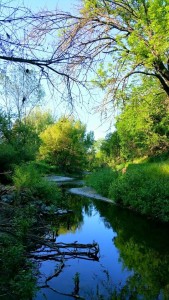Restoring The Napa River

The restoration of this secondary channel of the Napa River was made possible through the Rutherford Reach Restoration Project.
Photo: Gretchen Hayes
The Napa River, which has helped create soil perfect for grape-growing in the Napa Valley, is in danger. Fortunately, conscientious landowners are now working to preserve it.
The landowner-initiated Napa River Rutherford Reach Restoration Project has been implemented along a 4.5-mile reach of the river composed of 41 parcels of land owned by 30 entities, according to Jeremy Sarrow, restoration ecologist with the Napa County Flood Control & Water Conservation District. The area stretches along the main stem Napa River south of St. Helena, between Zinfandel Lane and the Oakville Cross Road.
“Changes in land use and management in the Napa River watershed have resulted in confinement of the river into a narrow channel, loss of riparian habitat, accelerated channel incision, bank erosion, and ongoing property loss,” Sarrow explains.
The project aims to address these issues with initiatives including:
- Setting back earthen berms from the top of the river bank;
- Expanding riparian habitat between the river and adjacent land uses, such as vineyards;
- Creating backwater habitat to provide high-flow refugia for native fish;
- Installing instream structures to improve aquatic habitat;
- Removing non-native invasive and Pierce’s disease host plants; and
- Stabilizing actively eroding banks to reduce fine sediment input.
Grape growers ripped out several acres of vines to make way for the changes.
“Landowners and grape growers were instrumental in rallying interest and support for the project,” Sarrow says, adding that in 2002, they began efforts to put together a Napa River restoration plan by creating a landowner advisory committee (LAC).
The LAC initially helped oversee the planning and implementation of the project, and an eventual partnership with Napa County brought everything to fruition. Acting as the lead agency, the county brought the project through the environmental review process, acquired regulatory permits, and also secured several state and federal grants. In addition, the county provided matching funds through a bond measure.
The construction phase of the project was completed in the fall of 2014. But, the work is far from done. “Biological monitoring and maintenance of constructed features and management of non-native and Pierce’s disease host vegetation is ongoing,” Sarrow says.
Supporting the project long-term makes good business sense for grape growers, Sarrow notes. “[They have] the ability to be a part of a significant effort to restore the health of the Napa River watershed, which has provided the basis for their livelihood,” he says.
In addition, the changes should mean an improved ability to manage Pierce’s disease, thanks to the removal of host vegetation. Growers will also have a greater influence over what happens on the riverside portion of their property, according to Sarrow.
“What makes the Rutherford Project so special is the commitment of all the various stakeholders, [including] landowners, regulatory agencies, local government, and non-governmental organizations, to reach consensus on what needs to be done to restore the Napa River and work together in a collaborative manner for the health of the river,” Sarrow says.
The next step is a restoration project further downstream from Rutherford Reach. The Oakville to Oak Knoll project will begin this summer, covering a 9-mile stretch. Sarrow says the goals will be similar to those of the Rutherford Reach project.









